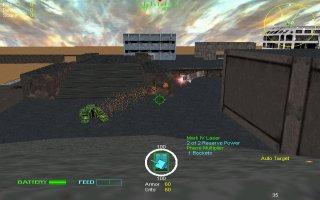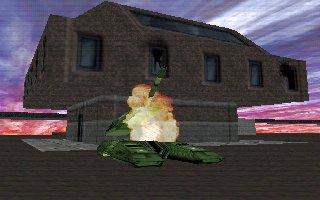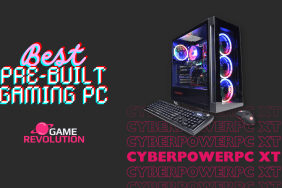My other car is a tank.
With the advancement of the internet, a new horizon has emerged: internet gaming. Network IP support, which was once a rare treat, is now being seen as a must among gamers everywhere. Tanarus, an online-only battle game, exemplifies Sony’s attempt to grab a piece of this action.
The basic idea behind Tanarus is simple: drive around and kill anything that isn’t on your team. Before the start of each game, the player must choose and equip a tank. There are 5 different tanks: the quick and light Lightning, the average Vanguard, the heavy and slow Devastator, the slow but almost invisible Chameleon, and the easily maneuverable MagRider. Each tank has both its advantages and disadvantages.
After choosing a tank, the next step is to equip it. There are a number of different modules that each tank (each with a different number of bays) can use. On the offensive side, players have the option to use cannons, laser weapons, Missiles, and Mines. On the defensive side, a shield and shield boost can be distributed to different sides of the tank. There are also 12 “special” modules that are not actually weapons, but that can be vital to the outcome of a battle. For example, Cloak makes a player hard to find, Night Vision allows the player to see in the dark etc. Lastly, three “Power Enhancements” can be used: Power Receiver, Reserve Power, and Supercharger.

This idea of “power” is the major factor behind the strategy of Tanarus. When starting a game, each team has their own base. Close to the base, there are a number of different satellites. When a player is close to his own satellite, his feed will be positive, and therefore he will be able to receive energy, used especially in laser weapons, and replenish his shields. Similar to this, when that same player is near or under an enemy satellite his feed is negative and his energy will decrease. Thus the best strategy involves venturing out beyond satellite range, but never straying to far from power, for the enemy is near.
As far as backgrounds go, Tanarus offers plenty of marvelous eye-candy through the sweet looking real-time graphics. With the use of a 3D accelerator, all rendered backgrounds, especially the sky and sun, look great. Transparent smoke, and different lighting effects (the day and night cycles, for example) all enhance the graphical aspect of the game. Tanks, however, look a little on the foolish side, due to a low polygon count, but the game nevertheless runs at a smooth frame-rate with a minimal amount of internet latency.
The actual playing of the game includes the basic controls that one might expect from a tank game: accelerate, decelerate, turn left, turn right, fire, along with the other “random” keys: initialize night vision, enable this, enable that etc. A joystick is supported (and recommended) thus simplifying the task of playing to the point that a laboratory rhesus monkey could figure it out. There is really not much strategical planning necessary to play. The only really key move is circling around a person and shooting before he/she can turn to fire back.
The bottom line is that Tanarus is a solid online game, but really nothing to get too excited about. On one side, it has good graphics, and fast, easy network support. However, the gameplay can quickly get repetitive (especially when playing in a “newbie” room) and there isn’t enough depth to keep you coming back after the shine has worn off.
-
Good graphics
-
Good use of 3D acceleration
-
Easy network (getting patches etc)
-
Lot of modules
-
Game-play gets old











